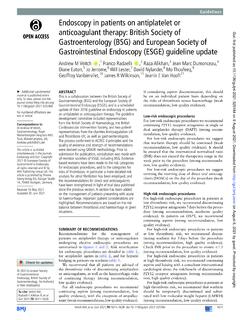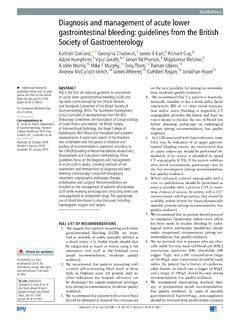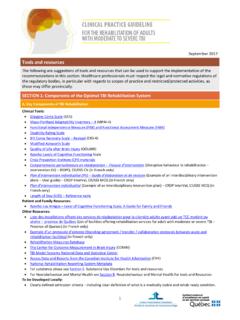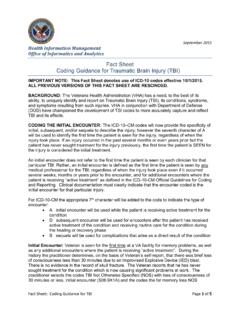Transcription of Guidelines on the management of ascites in cirrhosis
1 1 Aithal GP, et al. Gut 2020;0:1 21. on the management of ascites in cirrhosisGuruprasad P Aithal ,1,2 Naaventhan Palaniyappan,1,2 Louise China,3 Suvi H rm l ,4 Lucia Macken ,5,6 Jennifer M Ryan,3,7 Emilie A Wilkes,2,8 Kevin Moore,3 Joanna A Leithead,9 Peter C Hayes,10 Alastair J O Brien ,3 Sumita Verma5,6To cite: Aithal GP, Palaniyappan N, China L, et al. Gut Epub ahead of print: [please include Day Month Year]. Additional material is published online only. To view, please visit the journal online (http:// dx. doi. org/ 10. 1136/ gutjnl- 2020- 321790).For numbered affiliations see end of toProfessor Guruprasad P Aithal, NIHR Nottingham Biomedical Research Centre, Nottingham University Hospitals NHS Trust and the University of Nottingham, Nottingham NG7 2UH, UK; guru. aithal@ nottingham. ac. ukReceived 11 May 2020 Revised 27 August 2020 Accepted 4 September 2020 Author(s) (or their employer(s)) 2020. Re- use permitted under CC BY- NC. No commercial re- use. See rights and permissions.
2 Published by British Society of Gastroenterology in collaboration with British Association for the Study of the Liver has prepared this document. The aim of this guideline is to review and summarise the evidence that guides clinical diagnosis and management of ascites in patients with cirrhosis . Substantial advances have been made in this area since the publication of the last guideline in 2007. These Guidelines are based on a comprehensive literature search and comprise systematic reviews in the key areas, including the diagnostic tests, diuretic use, therapeutic paracentesis, use of albumin, transjugular intrahepatic portosystemic stent shunt, spontaneous bacterial peritonitis and beta- blockers in patients with ascites . Where recent systematic reviews and meta- analysis are available, these have been updated with additional studies. In addition, the results of prospective and retrospective studies, evidence obtained from expert committee reports and, in some instances, reports from case series have been included.
3 Where possible, judgement has been made on the quality of information used to generate the Guidelines and the specific recommendations have been made according to the Grading of Recommendations Assessment, Development and Evaluation (GRADE) system. These Guidelines are intended to inform practising clinicians, and it is expected that these Guidelines will be revised in 3 years SUMMARY OF RECOMMENDATIONS1. Diagnostic paracentesis in new- onset A diagnostic paracentesis is recommended in all patients with new- onset ascites . (Qual-ity of evidence : moderate ; Recommendation: strong) The initial ascitic fluid analysis should in-clude total protein concentration and calcu-lation of the serum ascites albumin gradient (SAAG). (Quality of evidence : moderate ; Rec-ommendation: strong) ascites fluid analysis for cytology, amylase, brain natriuretic peptide (BNP) and adenosine deaminase should be considered based on pre-test probability of specific diagnosis (Quality of evidence : moderate ; Recommendation: weak)2.
4 Spontaneous bacterial Diagnostic paracentesis should be carried out without a delay to rule out spontaneous bacterial peritonitis SBP) in all cirrhotic patients with ascites on hospital admission. (Quality of evidence : moderate ; Recommendation: strong) A diagnostic paracentesis should be per-formed in patients with GI bleeding, shock, fever or other signs of systemic inflammation, gastrointestinal symptoms, hepatic encephalop-athy, and in patients with worsening liver or renal function. (Quality of evidence : moderate ; Recommendation: strong) Ascitic neutrophil >250/mm3 count re-mains the gold standard for the diagnosis of SBP and this can be performed either by manual mi-croscopy or using automated counts, based on flow cytometry for counting and differentiating cells. (Quality of evidence : moderate ; Recom-mendation: strong) Ascitic fluid culture with bedside inoc-ulation of blood culture bottles should be performed to guide the choice of antibiotic treatment when SBP is suspected.
5 (Quality of evidence : moderate ; Recommendation: strong) Immediate empirical antibiotic therapy should be determined with due consideration of context of SBP (community acquired or health-care associated), severity of infection and lo-cal bacterial resistance profile. Cefotaxime has been widely studied, but choice of antibiotic should be guided by local resistance patterns and protocol. (Quality of evidence : moderate ; Recommendation: strong) A second diagnostic paracentesis at 48 hours from the start of treatment to check the efficacy of antibiotic therapy should be consid-ered in those who have apparently inadequate response or where secondary bacterial peritoni-tis is suspected. (Quality of evidence : low; Rec-ommendation: weak) Patients presenting with gastrointestinal bleeding and underlying ascites due to cirrhosis should receive prophylactic antibiotic treatment (cefotaxime has been widely studied but the an-tibiotic should be chosen based on local data) to prevent the development of SBP.
6 (Quality of evidence : strong; Recommendation: strong) Patients who have recovered from an ep-isode of SBP should be considered for treat-ment with norfloxacin (400 mg once daily), ciprofloxacin (500 mg once daily, orally) or co- trimoxazole (800 mg sulfamethoxazole and 160 mg trimethoprim daily, orally) to prevent fur-ther episode of SBP. (Quality of evidence : low; Recommendation: weak) Primary prophylaxis should be offered to patients considered at high risk, as defined by an ascitic protein count < g/dL. However, it on October 17, 2020 by guest. Protected by : first published as on 16 October 2020. Downloaded from 2 Aithal GP, et al. Gut 2020;0:1 21. important that the potential risks and benefits and existing uncertainties are communicated to patients. (Quality of evi-dence: low; Recommendation: weak)3. Dietary salt Patients with cirrhosis and ascites should have a mod-erately salt restricted diet with daily salt intake of no more than 5 g (87 113 mmol sodium).
7 This translates to a no added salt diet with avoidance of precooked meals. (Quality of evidence : moderate ; Recommendation: strong) Patients with cirrhosis and ascites should receive nutri-tional counselling on the sodium content in the diet. (Quality of evidence : weak; Recommendation: strong)4. In patients with the first presentation of moderate as-cites, spironolactone monotherapy (starting dose 100 mg, increased to 400 mg) is reasonable. In those with recurrent severe ascites , and if faster diuresis is needed (for example, if the patient is hospitalised), combination therapy with spironolactone (starting dose 100 mg, increased to 400 mg) and furosemide (starting dose 40 mg, increased to 160 mg) is recommended. (Quality of evidence : moderate ; Recommen-dation: strong) All patients initiating diuretics should be monitored for adverse events. Almost half of those with adverse events re-quire diuretic discontinuation or dose reduction. (Quality of evidence : low; Recommendation: weak) Hypovolaemic hyponatraemia during diuretic therapy should be managed by discontinuation of diuretics and ex-pansion of plasma volume with normal saline.
8 (Quality of evidence : low; Recommendation: weak) Fluid restriction to 1 L/day should be reserved for those who are clinically hypervolaemic with severe hypon-atraemia (serum sodium <125 mmol/L). (Quality of evi-dence: low; Recommendation: weak) Hypertonic sodium chloride (3%) administration should be reserved for those who are severely symptomatic with acute hyponatraemia. Serum sodium should be slowly cor-rected. (Quality of evidence : low; Recommendation: weak) It may be appropriate to consider use of midodrine in re-fractory ascites on a case by case basis. (Quality of evidence : low; Recommendation: weak)5. Large volume paracentesis (LVP) Patients should give informed consent for a therapeutic or diagnostic paracentesis. (Quality of evidence : low; Recom-mendation: strong) Ultrasound guidance should be considered when availa-ble during LVP to reduce the risk of adverse events (Quality of evidence : low; Recommendation: weak) Routine measurement of the prothrombin time and platelet count before therapeutic or diagnostic paracente-sis and infusion of blood products are not recommended.
9 (Quality of evidence : moderate ; Recommendation: strong)6. Use of human albumin solution (HAS) Albumin (as 20% or 25% solution) should be infused after paracentesis of >5 L is completed at a dose of 8 g albu-min/L of ascites removed. (Quality of evidence : high; Recom-mendation: strong) Albumin (as 20% or 25% solution) can be considered after paracentesis of <5 L at a dose of 8 g albumin/L of as-cites removed in patients with ACLF or high risk of post- paracentesis acute kidney injury. (Quality of evidence : low; Recommendation: weak) In patients with SBP and an increased serum creatinine or a rising serum creatinine, infusion of g albumin/kg within 6 hours of diagnosis, followed by 1 g/kg on day 3, is recommended. (Quality of evidence : low; Recommendation: weak)7. Transjugular intrahepatic portosystemic shunt (TIPSS) TIPSS should be considered in patients with refractory ascites . (Quality of evidence : high; Recommendation: strong) Caution is required if considering TIPSS in patients with age >70 years, serum bilirubin >50 mol/L, platelet count <75 109/L, model for end- stage liver disease (MELD) score 18, current hepatic encephalopathy, active infection or hepatorenal syndrome.
10 (Quality of evidence : moderate ; Rec-ommendation: strong)8. Umbilical Suitability and timing of surgical repair of umbilical her-nia should be considered in discussion with the patient and multidisciplinary team involving physicians, surgeons and anaesthetists. (Quality of evidence : low; Recommendation: strong)9. Hepatic hydrothorax (HH) TIPSS should be considered in patients with HH after discussion with the multidisciplinary team. (Quality of evi-dence: low; Recommendation: strong) In patients with HH who are not undergoing a TIPSS and/or a liver transplant evaluation, alternative palliative in-terventions should be considered. (Quality of evidence : low; Recommendation: strong)10. Non- selective beta- blockers (NSBB) and Refractory ascites should not be viewed as a contrain-dication to NSBB. (Quality of evidence : moderate ; Recom-mendation: strong) Patients with refractory ascites who are taking NSBB should be monitored closely, and dose reduction or discon-tinuation may be appropriate in those who develop hypo-tension or acute/progressive renal dysfunction.












